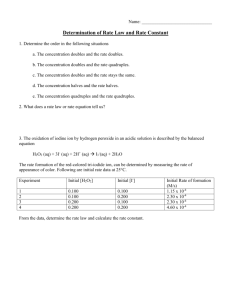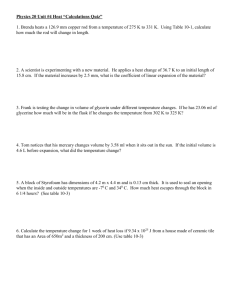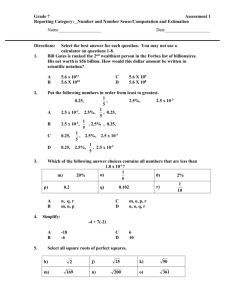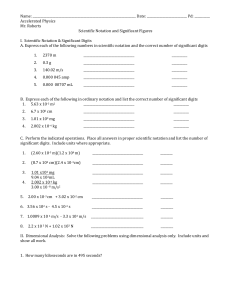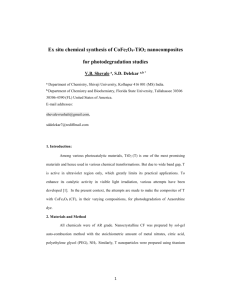concentrations acids
advertisement
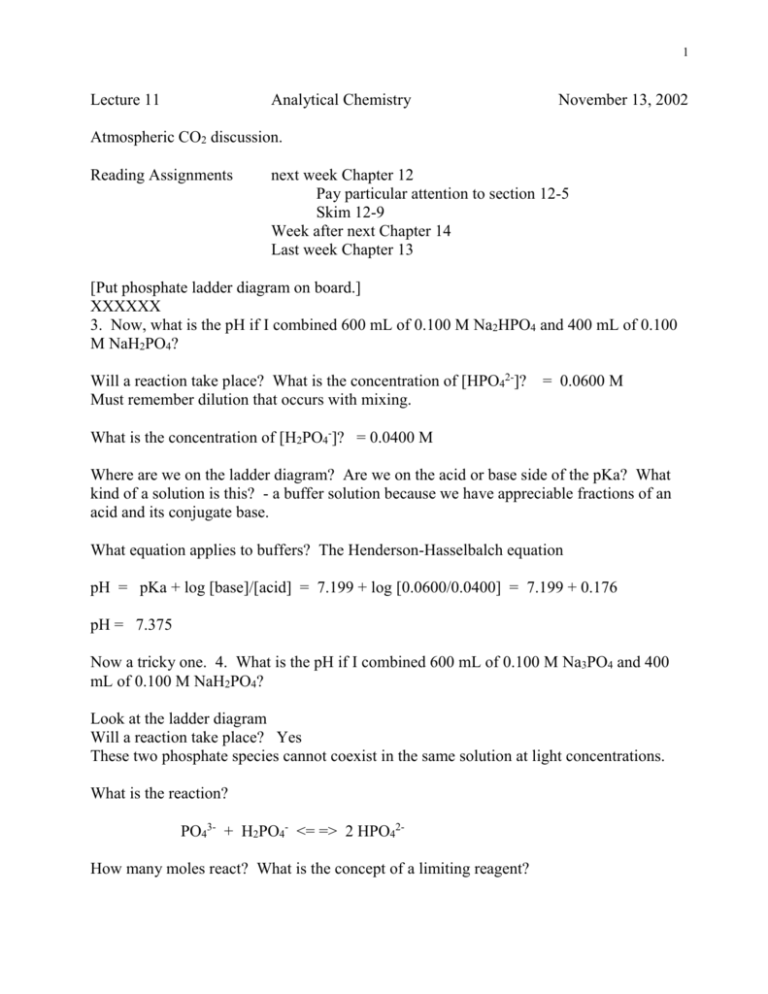
1
Lecture 11
Analytical Chemistry
November 13, 2002
Atmospheric CO2 discussion.
Reading Assignments
next week Chapter 12
Pay particular attention to section 12-5
Skim 12-9
Week after next Chapter 14
Last week Chapter 13
[Put phosphate ladder diagram on board.]
XXXXXX
3. Now, what is the pH if I combined 600 mL of 0.100 M Na2HPO4 and 400 mL of 0.100
M NaH2PO4?
Will a reaction take place? What is the concentration of [HPO42-]?
Must remember dilution that occurs with mixing.
= 0.0600 M
What is the concentration of [H2PO4-]? = 0.0400 M
Where are we on the ladder diagram? Are we on the acid or base side of the pKa? What
kind of a solution is this? - a buffer solution because we have appreciable fractions of an
acid and its conjugate base.
What equation applies to buffers? The Henderson-Hasselbalch equation
pH = pKa + log [base]/[acid] = 7.199 + log [0.0600/0.0400] = 7.199 + 0.176
pH = 7.375
Now a tricky one. 4. What is the pH if I combined 600 mL of 0.100 M Na3PO4 and 400
mL of 0.100 M NaH2PO4?
Look at the ladder diagram
Will a reaction take place? Yes
These two phosphate species cannot coexist in the same solution at light concentrations.
What is the reaction?
PO43- + H2PO4- <= => 2 HPO42How many moles react? What is the concept of a limiting reagent?
2
How many moles do we have of each?
Phosphate 0.0600 moles
Dihydrogen phosphate 0.0400 moles this is limiting
0.0400 moles of dihydrogen phosphate react to form 0.0400 moles of hydrogen phosphate.
0.0400 moles of phosphate react to form 0.0400 moles of hydrogen phosphate.
After reaction we have 0.0800 moles of HPO42- in one liter for a concentration of 0.0800 M
We also have 0.0200 moles of phosphate left for 0.0200 M phosphate.
Where are we on the ladder diagram? Are we on the acid or base side of the pKa? What
kind of a solution is this? - a buffer solution because we have appreciable fractions of an
acid and its conjugate base.
What equation applies to buffers? The Henderson-Hasselbalch equation
pH = pKa + log [base]/[acid] = 12.15 + log [0.0200/0.0800] = 12.15- 0.60
pH = 11.55
Workshop/Homework Problems
1. Calculate the hydrogen ion concentration in 0.120 M nitrous acid.
Is this a weak acid? How do you tell? What kind of solution is this?
The principal equilibrium is
HNO2
< == > H+ + NO2-
from (Appendix G, page AP23)
Ka = 7.1 x 10-4 = [H+][NO2-]
[HNO2]
This is a monoprotic acid so let x = [H+] = [NO2-]
and [HNO2] = F – x
Ka = 7.1 x 10-4 = x2/(F – x)
This can be solved by the quadratic equation or by approximation. Let’s use
approximation by assuming x small compared to F
3
x2 = Ka F =
7.1 x 10-4 x 0.120
x1 = 9.23 x 10-3
what limits the sig figs in
answer?
so x is 9.23x10-3/0.120 = 8 % of F.
Now set [HNO2] = 0.120 - 9.23 x 10-3 = 0.11077
x2 = Ka F = 7.1 x 10-4 x 0.11077
a third round gives
x2 = 8.86 x 10-3 M
x2 = Ka F =
x3 = 8.88 x 10-3 M
7.1 x 10-4 x 0.11114
or x = 8.9 x 10-3 M since our answer should be to only 2 sig figs.
So we have two approximations in a row that are 8.9 to two significant figures.
2. Use activities to calculate the hydrogen ion concentration in a 0.120 M solution of
HNO2 that is also 0.050 M in NaCl.
What we need first is the ionic strength of the solution. We will use the values from
problem one for our H+ and NO2- concentrations
= ½[(0.050)12+(0.050)(-1)2+(8.88x10-3)12 +(8.88x10-3)(-1)2]
= 0.0589 M
Ka = [H+]H+ [NO2-]NO2[HNO2]HNO2
Interpolating from Table 8-1, H+ = 0.86 at 0.05 and 0.83 at 0.1 = 0.855 at 0.0589
NO2- = 0.805 at 0.05 and 0.755 at 0.1 so = 0.796 at 0.0589
HNO2 is uncharged so = 1.0
7.1 x 10-4 = x2 (0.855)(0.796) / (0.120 –x)
first approximation
x2 = 1.043 x 10-3 ( 0.120 – x)
x1 = 1.112 x 10-2
4
Now set [HNO2] = 0.120 - .0111 = 0.1089
x2 = 1.043 x 10-3 x 0.1089
x2 = 0.01066
[HNO2] = 0.120 - .01066 = 0.1093
a third try
x2 = 1.043 x 10-3 x 0.1093
sig figs
x3 = 0.01068 = 1.07 x 10-2 M or 1.1 x 10-2 M to two
So the presence of the salt makes the acid dissociate more (by about 20%) because the
ionic atmosphere around each ion shields them from each other to some extent.
But wait, we need to correct the ionic strength for these new values as the ionic strength is
now larger than we assumed at the start.
= ½[(0.050)12+(0.050)(-1)2+(1.1x10-2)12 +(1.1x10-2)(-1)2]
= 0.0610
Interpolating again from Table 8-1, H+ = 0.86 at 0.05 and 0.83 at 0.1 = 0.853 at
0.0610
NO2- = 0.805 at 0.05 and 0.755 at 0.1 so = 0.794 at 0.0610
Will this make a big difference?
x2 = 1.048 x 10-3 x 0.1093
x = 1.070 x 10-2 not that much different from 1.068
and the same at 2 sig figs 1.1x 10-2 M
3. Calculate the hydrogen ion concentration for a buffer solution that is 0.200 M in citric
acid and 0.150 M in sodium dihydrogen citrate.
The principal equilibrium in this solution is the dissociation of citric acid.
H3Citrate
< == > H+ + H2Citrate-
Kal = 7.44 x 10-4
pKa1 = 3.128
pH = pKa + log [H2Citrate-]/[H3Citrate]
pH = 3.128 + log 0.150/0.200 = 3.128 – 0.125 = 3.003
5
4.
(11-23)
The diprotic acid H2A has pK1 = 4.00 and pK2 = 8.00.
(a) At what pH is [H2A] = [HA-]?
4.00
2(b) At what pH is [HA ] = [A ]?
8.00
(c) Which is the principal species at pH 2.00?
H2 A
(d) Which is the principal species at pH 6.00?
HA(e) Which is the principal species at pH 10.00? A25. On Monday you determined that the pH of ionized water in equilibrium with carbon
dioxide in the air has a pH of 5.62. Here is a related problem. Suppose we have 1.00 L of
a 0.100 M solution of NaOH. We leave this solution exposed to the atmosphere and allow
the system to come to equilibrium (assume no evaporation of the solution). What
reaction(s) take place and what is the pH of the solution when it attains equilibrium?
First what do we know about NaOH? Is it a strong or weak base? Strong
What is the pH of this solution 13.000
What do strong bases do when they encounter weak acids? React completely.
What is the chemical equation for this reaction?
H2CO3 + OH- < == > HCO3- + H2O
What is the equilibrium constant for this reaction?
H2CO3 < == > HCO3- + H+
K1 = 4.45 x 10-7
OH- + H+ < == > H2O
H2CO3 + OH- < == > HCO3- + H2O
1/Kw = 1.00 x 1014
K = K1/Kw = 4.45 x 107
So we will ultimately end up with a solution of NaHCO3- at a concentration of 0.100 M.
If we think about the reaction this way we could approximate the pH by solving the above
for hydroxide as if we started with sodium bicarbonate. Let x = [OH-]
K = 0.100/x2 x2 = 0.100/K x = [0.100/(4.45 x 107)]1/2 = 4.74 x 10-5 M
pOH = 4.32 pH = 9.68
But the carbonic acid concentration is also determined by the equilibrium with the
atmosphere.
6
H2CO3 + OH- < == > HCO3- + H2O
Kx = K1/Kw = 4.45 x 107
CO2(g) <= => H2CO3
Kg = 0.0344
CO2(g) + OH- < == > HCO3- + H2O
Ky = (4.45 x 107)(0.0344) = 1.53 x 106
Ky = [HCO3-] [OH-] = [HCO3-] = 0.100/[(3.7 x 10-4)(1.53 x 106) = 1.77 x 10-4 M
PCO2[OH-]
PCO2Ky
pOH = 3.75 pH = 14 – 3.75 = 10.25
Another way to think about this is that 0.100 M bicarbonate reacts further with the air to
give more bicarbonate and H+.
CO2(g) <= => H2CO3
Kg = 0.0344
H2CO3(aq) <= => H+ + HCO3-
Ka1 = 4.45 x 10-7
CO2(g) <= =>
3.7x10-4
K = [H+][HCO3-]
PCO2
pH = 10.25
H+ + HCO3x
0.100 + x
[H+] =
K PCO2 =
[HCO3-]
K = Kg*Ka1 = 1.53 x 10-8
(1.53 x 10-8)(3.7 x 10-4)/0.100 = 5.66 x 10-11
6. (11-5) We will abbreviate malonic acid, CH2(CO2H)2, as H2M. Find the pH and
concentrations of H2M, HM- and M2- in (a) 0.100 M H2M; (b) 0.100 M NaHM; (c) 0.100 M
Na2M. [If you are interested, use the method of Box 11-1 for part (b).]
We first need the Ka’s.
Ka1 = 1.42 x 10-3 pKa1 = 2.847
Ka2 = 2.01 x 10-6 pKa2 = 5.696
(a) This is the acid solution x2 = Ka1 (F-x) = 1.42 x 10-3 (0.100 – x) assume x small
x1 = 0.0119
try again x2 = 1.42 x 10-3 (0.100 – .0119) = 1.25 x 10-4
x2 = 0.0112
last time try again x2 = 1.42 x 10-3 (0.100 – .0112) = 1.26 x 10-4
x2 = 0.0112
[HM-] = [H+] = 0.0112 M; pH = 1.951
[H2M] = (0.100 – 0.0112) = 0.089 M Why only 2 sig figs?
Ka2 = [H+][M2-] [M2-] = Ka2 * [HM-] / [H+] = 2.01 x 10-6 * 0.0112/0.0112
[HM-]
[M2-] = 2.01 x 10-6
7
(b) [HM-] = F = 0.100 M
_________________
+
[H ] = / Ka1Ka2F + Ka1Kw
√
Ka1 + F
_______________________________________________
[H+] = / 1.42 x 10-3* 2.01 x 10-6*0.100 + 1.42 x 10-3 * 1.0 x 10-14
√
1.42 x 10-3 + 0.100
= { (2.85 x 10-10 + small)/ 0.101 }1/2
[H+] = 5.32 x 10-5 M
pH = 4.274
our other method was pH = ½ ( 2.847 + 5.696) = 4.272
[M2-] = Ka2 * [HM-] / [H+] = 2.01 x 10-6 * 0.100/(5.32 x 10-5) = 3.78 x 10-3 M
We should be at the point where [H2M] = [M2-]. Let’s try the calculation and see.
Ka1 = [H+][HM-] [H2M] = [H+] [HM-] / Ka1 = 5.32 x 10-5 * 0.100 / 1.42 x 10-3
[H2M]
[H2M] = 3.75 x 10-3 M pretty close
(c) This system can be solved as a base.
M2+ + HOH <= => HM- + OH0.100 –x
x
Kb = Kw/Ka2 = 1.00 x 10-14/ 2.01 x 10-6
= 4.98 x 10-9
x
x2 = 4.98 x 10-9 (0.100 – x) assume small
x = 2.23 x 10-5 is indeed small
[HM-] = [OH-] = 2.23 x 10-5 M pOH = 4.652 pH = 14.000 – 4.652 = 9.348
[H+] = 10-9.348 = 4.48 x 10-10
[H2M] = [H+] [HM-] / Ka1 = 4.48 x 10-10 * 2.23 x 10-5 / 1.42 x 10-3
[H2M] = 7.04 x 10-12 M
7) (11-11) How many grams of Na2CO3 (FW 105.99) should be mixed with 5.00 g of
NaHCO3 (FW 84.01) to produce 1.00 x 102 mL of buffer with pH 10.00?
This problem can be solved several ways. If we start with the Henderson-Hasselbalch
equation we can solve for the ratio of the moles of base to acid and then from the moles of
8
conjugate acid determine the moles of conjugate base. Or we can solve the problem in one
step by putting the unknown directly in the H-H equation.
the pKa is for the second dissociation of carbonic acid
which is pKa2 = 10.329
10.0 = 10.329 + log [ratio] log [ratio] = -0.329 [ratio] = 10-.329 = 0.4688
moles conjugate acid = 5.00 g HCO3- x 1 mole / 84.01 g = 0.0595 mol HCO3moles conjugate base = x g Na2CO3 x 1 mol/105.99 g = x/105.99
[CO32-] = [HCO3-] * [ratio]
x = 0.0595 mol * 0.4688 * 105.99 = 2.96 g Na2CO3
OR
pH = pKa + log [CO32-]/[HCO3-]
10.0 = 10.329 + log [ x/105.99] / [ 5.00 /84.01]
-0.329 = log 0.1585x = log 0.1585 + log x = -0.800 + log x
log x = 0.471 x = 100.471 = 2.96 g Na2CO3
8) (11-16) (a) Calculate the quotient [H3PO4]/[H2PO4-] in 0.0500 M KH2PO4.
(b) Find the same quotient for 0.0500 M K2HPO4.
(a) Part a is a solution of an intermediate species for phosphoric acid so
_________________
+
[H ] = / Ka1Ka2F + Ka1Kw
√
Ka1 + F
= {( 7.11 x 10-3 * 6.32 x 10-8 * 0.0500 + 7.11 x 10-3* 1.0 x 10-14 )/( 0.00711 +0.0500)}1/2
= { (2.247 x 10-11 + 7.11 x 10-17)/ 0.0571}1/2
= { 2.247 x 10-11/0.0571 }1/2 = { 3.935 x 10-10 }1/2 = 1.98 x 10-5 M
pH = 4.703
We can use the first Ka H-H equation to get the desired ratio. [Even though this is not a
buffer problem, since we have both the pH and the pKa, and since the H-H equation is
always true, we can use it to get the ratio we want.]
4.703 = 2.148 + log [H2PO4-]/[H3PO4]
9
log [H2PO4-]/[H3PO4] = 2.555
[H2PO4-]/[H3PO4] = 102.555 = 359
we want the inverse
[H3PO4]/[H2PO4-] = 1/(359) = 2.79 x 10-3
(b) Part b is also a solution of the second intermediate species for phosphoric acid so
__________________
[H+] = / Ka2Ka3F + Ka2Kw
√
Ka2 + F
= {( 6.32 x 10-8* 7.1 x 10-13* 0.0500 + 6.32 x 10-8* 1.0 x 10-14 )/0.0500}1/2
= { (2.237 x 10-21 + 6.32 x 10-22)/ 0.0500}1/2
= { 2.869 x 10-21/0.0500 }1/2 = { 5.738 x 10-20 }1/2 = 2.40 x 10-10 M
pH = 9.621
Again we use the first Ka H-H equation to get the desired ratio.
9.621 = 2.148 + log [H2PO4-]/[H3PO4]
log [H2PO4-]/[H3PO4] = 7.473
[H2PO4-]/[H3PO4] = 107.473 = 2.97 x 107
we want the inverse
[H3PO4]/[H2PO4-] = 1/(2.97 x 107) = 3.37 x 10-8



